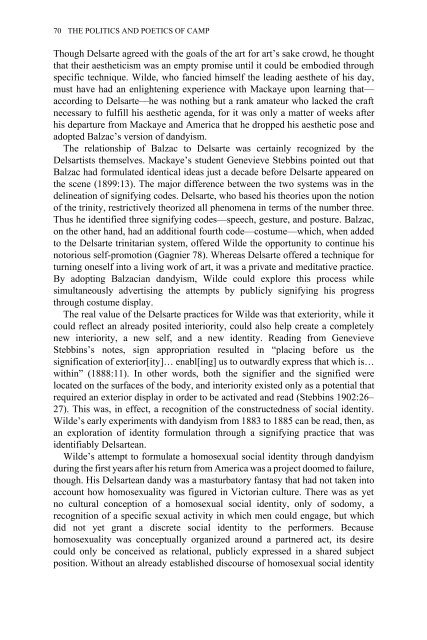Edited by Moe Meyer - Get a Free Blog
Edited by Moe Meyer - Get a Free Blog
Edited by Moe Meyer - Get a Free Blog
Create successful ePaper yourself
Turn your PDF publications into a flip-book with our unique Google optimized e-Paper software.
70 THE POLITICS AND POETICS OF CAMP<br />
Though Delsarte agreed with the goals of the art for art’s sake crowd, he thought<br />
that their aestheticism was an empty promise until it could be embodied through<br />
specific technique. Wilde, who fancied himself the leading aesthete of his day,<br />
must have had an enlightening experience with Mackaye upon learning that—<br />
according to Delsarte—he was nothing but a rank amateur who lacked the craft<br />
necessary to fulfill his aesthetic agenda, for it was only a matter of weeks after<br />
his departure from Mackaye and America that he dropped his aesthetic pose and<br />
adopted Balzac’s version of dandyism.<br />
The relationship of Balzac to Delsarte was certainly recognized <strong>by</strong> the<br />
Delsartists themselves. Mackaye’s student Genevieve Stebbins pointed out that<br />
Balzac had formulated identical ideas just a decade before Delsarte appeared on<br />
the scene (1899:13). The major difference between the two systems was in the<br />
delineation of signifying codes. Delsarte, who based his theories upon the notion<br />
of the trinity, restrictively theorized all phenomena in terms of the number three.<br />
Thus he identified three signifying codes—speech, gesture, and posture. Balzac,<br />
on the other hand, had an additional fourth code—costume—which, when added<br />
to the Delsarte trinitarian system, offered Wilde the opportunity to continue his<br />
notorious self-promotion (Gagnier 78). Whereas Delsarte offered a technique for<br />
turning oneself into a living work of art, it was a private and meditative practice.<br />
By adopting Balzacian dandyism, Wilde could explore this process while<br />
simultaneously advertising the attempts <strong>by</strong> publicly signifying his progress<br />
through costume display.<br />
The real value of the Delsarte practices for Wilde was that exteriority, while it<br />
could reflect an already posited interiority, could also help create a completely<br />
new interiority, a new self, and a new identity. Reading from Genevieve<br />
Stebbins’s notes, sign appropriation resulted in “placing before us the<br />
signification of exterior[ity]… enabl[ing] us to outwardly express that which is…<br />
within” (1888:11). In other words, both the signifier and the signified were<br />
located on the surfaces of the body, and interiority existed only as a potential that<br />
required an exterior display in order to be activated and read (Stebbins 1902:26–<br />
27). This was, in effect, a recognition of the constructedness of social identity.<br />
Wilde’s early experiments with dandyism from 1883 to 1885 can be read, then, as<br />
an exploration of identity formulation through a signifying practice that was<br />
identifiably Delsartean.<br />
Wilde’s attempt to formulate a homosexual social identity through dandyism<br />
during the first years after his return from America was a project doomed to failure,<br />
though. His Delsartean dandy was a masturbatory fantasy that had not taken into<br />
account how homosexuality was figured in Victorian culture. There was as yet<br />
no cultural conception of a homosexual social identity, only of sodomy, a<br />
recognition of a specific sexual activity in which men could engage, but which<br />
did not yet grant a discrete social identity to the performers. Because<br />
homosexuality was conceptually organized around a partnered act, its desire<br />
could only be conceived as relational, publicly expressed in a shared subject<br />
position. Without an already established discourse of homosexual social identity


